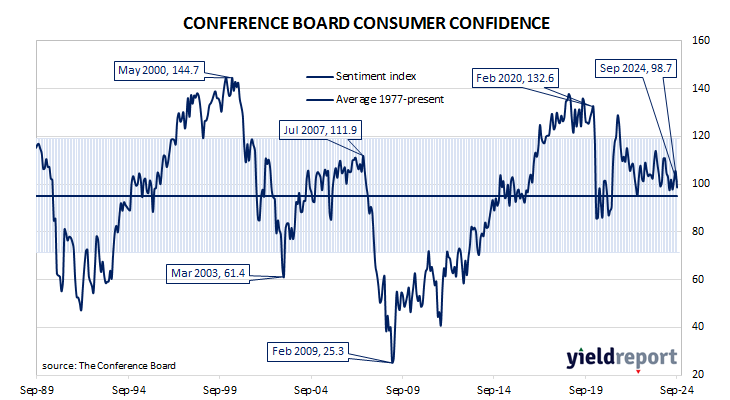Summary: Conference Board Consumer Confidence Index down in September, below expectations; largest decline since August 2021; US Treasury yields fall across steeper curve; expectations of Fed rate cuts firm, nearly 200bps of cuts expected in next 12 months; views of present conditions, short-term outlook both deteriorate; drop in confidence steepest for consumers aged 35 to 54.
US consumer confidence clawed its way back to neutral over the five years after the GFC in 2008/2009 and then went from strength to strength until late 2018. Measures of consumer confidence then oscillated within a relatively narrow band at historically high levels until they plunged in early 2020. Subsequent readings then fluctuated around the long-term average until March 2021 when they returned to elevated levels. However, a noticeable gap has since emerged between the two most-widely followed surveys.
The latest Conference Board survey completed just after the middle of September indicates its measure of US consumer confidence has continued bumping along at slightly-above-average levels. The latest reading of the Consumer Confidence Index registered 98.7 on a preliminary basis, below the generally-expected figure of 102.8 as well as August’s upwardly-revised final figure of 105.6.
“September’s decline was the largest since August 2021 and all five components of the Index deteriorated,” said Dana Peterson, Chief Economist at The Conference Board.
US Treasury bond yields fell across a steeper curve on the day. By the close of business, the 2-year Treasury bond yield had shed 4bps to 3.54%, the 10-year yield had lost 2bps to 2.73% while the 30-year yield finished unchanged at 4.09%.
In terms of US Fed policy, expectations of a lower federal funds rate in the next 12 months firmed, with at least another seven 25bp cuts still factored in. At the close of business, contracts implied the effective federal funds rate would average 4.515% in November, 4.255% in December and 3.68% in February. August 2025 contracts implied 2.905%, 193bps less than the current rate.
Consumers’ views of present conditions and the near-future both deteriorated. The Present Situation Index decreased from August’s revised figure of 134.6 to 124.3 while the Expectations Index declined from 86.3 to 81.7.
“The drop in confidence was steepest for consumers aged 35 to 54,” Peterson added. “As a result, on a six-month moving average basis, the 35–54 age group has become the least confident while consumers under 35 remain the most confident. Confidence declined in September across most income groups, with consumers earning less than $50,000 experiencing the largest decrease.”
The Consumer Confidence Survey is one of two widely followed monthly US consumer sentiment surveys which produce sentiment indices. The Conference Board’s index is based on perceptions of current business and employment conditions, as well as respondents’ expectations of conditions six months in the future. The other survey, conducted by the University of Michigan, is similar and it is used to produce an Index of Consumer Sentiment. That survey differs in that it does not ask respondents explicitly about their views of the labour market and it also includes some longer-term questions.



